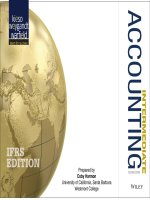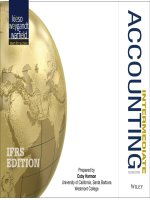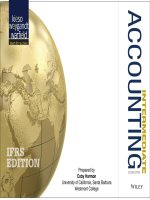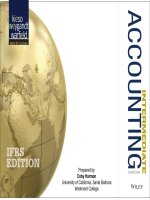Lecture Intermediate accounting (IFRS/e) - Chapter 17: Pensions and other postemployment benefits
Bạn đang xem bản rút gọn của tài liệu. Xem và tải ngay bản đầy đủ của tài liệu tại đây (1.17 MB, 51 trang )
Chapter 17
PENSIONS AND OTHER
POSTEMPLOYMENT
BENEFIT PLANS
© 2013 The McGraw-Hill Companies, Inc.
Nature of Pension Plans
1. Pension plans provide income to
individuals during their retirement
years.
2. This is accomplished by setting aside
funds during an employee’s working
years so that at retirement, the
accumulated funds plus earnings from
investing those funds are available to
replace wages.
17 - 2
Nature of Pension Plans
For a pension plan to qualify for special tax
treatment it may need to meet the following
requirements:
1.Cover a substantial proportion of employees.
2.Cannot discriminate in favor of highly
compensated employees.
3.Must be funded in advance of retirement through
an irrevocable trust fund.
4.Benefits must vest after a specified period of
service.
5.Complies with timing and amount of
contributions.
17 - 3
Nature of Pension Plans
17 - 4
Defined Contribution Plans
Plan
Plan Characteristics
Characteristics
Contributions
Contributions
are
are defined
defined
by
by
agreement.
agreement.
17 - 5
Employer
Employer
deposits
deposits an
an
agreed-upon
agreed-upon
amount
amount into
into
an
an employeeemployeedirected
directed
investment
investment
fund.
fund.
Employee
Employee
bears
bears all
all risk
risk
of
of pension
pension
fund
fund
performance.
performance.
Defined Contribution Plans
Let’s assume that the annual contribution is to
be 3% of an employee’s salary. If an employee
earned $110,000 during the year, the company
would make the following entry:
Defined benefit expense
Cash
3,300
3,300
The employee’s retirement benefits are totally
dependent upon how well investments perform.
17 - 6
Defined Benefit Plans
Plan
Plan Characteristics
Characteristics
Employer
Employer is
is
committed
committed to
to
specified
specified
retirement
retirement
benefits
benefits..
17 - 7
Retirement
Retirement
benefits
benefits are
are
based
based on
on aa
formula
formula that
that
considers
considers
years
years of
of
service,
service,
compensation
compensation
level,
level, and
and age.
age.
Employer
Employer
bears
bears all
all risk
risk
of
of pension
pension
fund
fund
performance.
performance.
Defined Benefit Plan
A pension formula might define annual retirement
benefits as:
1 1/2 % x Years of service x Final year’s salary
By this formula, the annual benefits to an
employee who retires after 30 years of service,
with a final salary of $100,000, would be:
1 1/2 % x 30 years x $100,000 = $45,000
17 - 8
Defined Benefit Plan
An actuary assesses the various uncertainties
(employee turnover, salary levels, mortality, etc.)
and estimates the company’s obligation to
employees in connection with its pension plan.
The key elements of a defined benefit
plan are:
1.The employer’s obligation to pay
retirement benefits in the future.
2.The plan assets set aside by the
employer from which to pay the
retirement benefits in the future.
3.The periodic expense of having a
pension plan.
17 - 9
Defined Benefit Cost—An Overview
The annual defined benefit cost reflects
changes in both the defined benefit
obligation and the plan assets.
Components of Defined Benefit Cost
+
Service cost ascribed to employee service during the period
+
Interest accrued on the defined benefit liability
Return on the plan assets*
Past service cost attributed to employee service before an amendment to
the defined benefit plan
+ or (-) Losses or (gains) from revisions in the defined benefit liability or from
investing plan assets
=
Defined Benefit Cost
*The actual return is adjusted for any difference between actual and expected
return, resulting in the expected return being reflected in defined benefit expense.
This loss of gain from investing plan assets is combined with losses and gains
from revisions in the defined benefit liability.
17 - 10
The Defined Benefit Obligation
1. Accumulated benefit obligation The actuary’s estimate of
the total retirement benefits (at their discounted present
value) earned so far by employees, applying the pension
formula using existing compensation levels.
2. Vested benefit obligation The portion of the accumulated
benefit obligation that plan participants are entitled to
receive regardless of their continued employment.
3. Projected benefit obligation The actuary’s estimate of the
total retirement benefit (at their discounted present value)
earned so far by employees, applying the pension formula
using estimated future compensation levels. Under the
projected credit unit approach, units of benefits increase
with each year of service.
17 - 11
The Defined Benefit Obligation
17 - 12
Defined Benefit Obligation
The DBO as a measure of projected benefits is a
more meaningful measure because it includes a
projection of what the salary might be at retirement.
Jessica Farrow was hired by Global Communications in 2000. She is
eligible to participate in the company's defined benefit pension plan. The
benefit formula is:
Annual salary in year of retirement
× Number of years of service
× 1.5%
17 - 13
Defined Benefit Obligation
Step 1. Use the defined benefit formula to determine the retirement benefits
earned to date.
$400,000
× 10
× 1.5%
$ 60,000 per year
Step 2. Find the present value of the retirement benefits as of the retirement
date.
The present value (n=20, i=6%,) of the retirement annuity at the
retirement date is $688,195 ($60,000 × 11.46992).
retirement date is $688,195 ($60,000
17 - 14
Defined Benefit Obligation
If the actuary’s estimate of the final salary hasn’t changed, the DBO a
year later at the end of 2010 would be $139,715.
Step 1. Use the defined benefit formula to determine the retirement benefits
earned to date.
$400,000
× 11
× 1.5%
$ 66,000 per year
Step 2. Find the present value of the retirement benefits as of the retirement
date.
17 - 15
The present value (n=20, i=6%,) of the retirement annuity at the
Defined Benefit Obligation
The Defined Benefits Obligation Changes as a Result of:
Cause
Effect
Frequency
Service Cost
+
Each period
Interest Cost
+
Each period (except the first period
of the plan, when no obligation
exists to accrue interest)
Past Service Cost
+
Only if the plan is amended (or
initiated) that period
Remeasurement
loss or gain
+ or -
Whenever revisions are made in the defined
benefit liability estimate or actual returns on
plan assets differ from expected returns
Retiree benefits paid
-
Each period (unless no employees have yet
retired under the plan)
17 - 16
Defined Benefit Obligation
The Defined Benefits Obligation Changes as a Result of:
Cause
Effect
Frequency
Service Cost
+
Each period
Interest Cost
+
Each period (except the first period
of the plan, when no obligation
exists to accrue interest)
Past Service Cost
+
Only if the plan is amended (or
initiated) that period
Remeasurement
loss or gain
+ or -
Whenever revisions are made in the defined
benefit liability estimate or actual returns on
plan assets differ from expected returns
Retiree benefits paid
-
Each period (unless no employees have yet
retired under the plan)
Service cost is the increase in the DBO attributable
to employee service performed during the period.
17 - 17
Defined Benefit Obligation
The Defined Benefits Obligation Changes as a Result of:
Cause
Effect
Frequency
Service Cost
+
Each period
Interest Cost
+
Each period (except the first period
of the plan, when no obligation
exists to accrue interest)
Past Service Cost
+
Only if the plan is amended (or
initiated) that period
Remeasurement
loss or gain
+ or -
Whenever revisions are made in the defined
benefit liability estimate or actual returns on
plan assets differ from expected returns
Retiree benefits paid
-
Each period (unless no employees have yet
retired under the plan)
Interest cost is the interest on the DBO during the
period.
17 - 18
Defined Benefit Obligation
The Defined Benefits Obligation Changes as a Result of:
Cause
Effect
Frequency
Service Cost
+
Each period
Interest Cost
+
Each period (except the first period
of the plan, when no obligation
exists to accrue interest)
Past Service Cost
+
Only if the plan is amended (or
initiated) that period
Remeasurement
loss or gain
+ or -
Whenever revisions are made in the defined
benefit liability estimate or actual returns on
plan assets differ from expected returns
Retiree benefits paid
-
Each period (unless no employees have yet
retired under the plan)
17 - 19
Past service cost is the increase in the DBO due to a plan
change that provides credit for employee service rendered in
prior years.
Defined Benefit Obligation
The Defined Benefits Obligation Changes as a Result of:
Cause
Effect
Frequency
Service Cost
+
Each period
Interest Cost
+
Each period (except the first period
of the plan, when no obligation
exists to accrue interest)
Past Service Cost
+
Only if the plan is amended (or
initiated) that period
Remeasurement
loss or gain
+ or -
Whenever revisions are made in the defined
benefit liability estimate or actual returns on
plan assets differ from expected returns
Retiree benefits paid
-
Each period (unless no employees have yet
retired under the plan)
Remeasurement loss or gain results from revising
estimates used to determine the DBO and from changes in
returns on plan assets.
17 - 20
Defined Benefit Obligation
The Defined Benefits Obligation Changes as a Result of:
Cause
Effect
Frequency
Service Cost
+
Each period
Interest Cost
+
Each period (except the first period
of the plan, when no obligation
exists to accrue interest)
Past Service Cost
+
Only if the plan is amended (or
initiated) that period
Remeasurement
loss or gain
+ or -
Whenever revisions are made in the defined
benefit liability estimate or actual returns on
plan assets differ from expected returns
Retiree benefits paid
-
Each period (unless no employees have yet
retired under the plan)
Retiree benefits paid reduce the DBO.
17 - 21
Defined Benefit Obligation
The changes in the DBO for Global Communications during 2011 were as follows:
DBO at the beginning of 2011† (amount assumed)
Service cost, 2011 (amount assumed)
Interest cost: $400 x 6%
Actuarial loss (gain) on DBO (amount assumed)
Less: Retiree benefits paid (amount assumed)
DBO at the end of 2011
($ in millions)*
$400
41
24
23
(38)
$450
*Of course, these expanded amounts are not simply the amounts for Jessica Farrow
multiplied by 2,000 employees because her years of service, expected retirement date, and
salary are not necessarily representative of other employees. Also, the expanded amounts
take into account expected employee turnover and current retirees.
†
Includes the past service cost that increased the DBO when the plan was amended in 2010.
17 - 22
Plan Assets
The plan assets are not reported separately in the
statement of financial position but are netted together
with the DBO to report either a net defined benefit asset
(debit balance) or a net defined benefit liability (credit
balance).
The higher the expected
return on plan assets, the less
the employer must actually
contribute. On the other hand,
a relatively low expected
return means the difference
must be made up by higher
contributions.
17 - 23
Plan Assets
Global Communications funds its defined benefit plan by
contributing the year’s service cost plus a portion of the
prior service cost each year. Cash of $48 million was
contributed to the pension fund in 2011.
Plan assets at the beginning of 2011 were valued at $300
million. The expected rate of return on the investment of
those assets was 9%, but the actual return in 2011 was
10%. Retirement benefits of $38 million were paid at the
end of 2011 to retired employees. The plan assets at the
end of 2011 will be:
Plan assets at the beginning of 2011
$
Return on plan assets (10% x $300 million)
30,000,000
Cash contributions
48,000,000
Less: Retiree benefits paid
Plan assets at the end of 2011
17 - 24
300,000,000
(38,000,000)
$
340,000,000
Funded Status of the Pension Plan
OVERFUNDED
Market value of plan
assets exceeds the
actuarial present value
of all benefits earned by
participants.
17 - 25
UNDERFUNDED
Market value of plan
assets is below the
actuarial present value
of all benefits earned by
participants.









